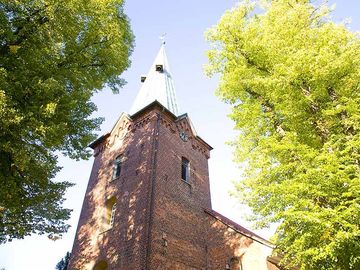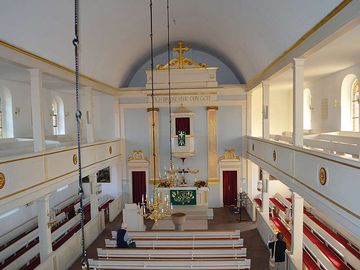The Three Kings Church
Protestant church
The Three Kings Church of the protestant community in the Old Town was erected here after the great fire of 1811. The first church was presumably erected here in 833. The inscription at the base of the golden altar cup indicates that the altar dates back to 1507 and that the church got its name prior to the Reformation.
The general layout of today's church dates back to 1736 when an apparently much larger Romanesque cross church in a state of decay was torn down. The Great Fire of 1811 destroyed most of the church, the corners of the tower collapsed - only the middle section with the numbers 7 and 3 from the year 1736 remained intact.
Today`s church is about the redesign of 1937
After reconstruction in 1812 the church was renovated entirely in 1903. Its appearance today with its 33 meters length and 17.5 meters width are the result of alterations made at that time. The larger windows with colored lead glass and the altar wall in the empire style also date back to this period: The wall depicts golden ears and grapes as an allegory to The Last Supper. The wall, which had previously been bare, was painted bright matte-grey and the columns were emphasized. Originally built in 1812 and fundamentally renewed in 1903, the highly simplistic main hall of the church was completely renovated.
Some figures of apostels and angels, chandeliers and altar barriers were removed from the interior and the spatial arrangement was focused on the altar wall, the pulpit and baptismal font. The clear forms of the empire style were emphasized, redundant decoration was removed, the walls were painted with a subtle yellow, lofts and seating were gradated in color between white gray and ivory. Along with the white vaults the view is directed to the altar and the hall of church seems larger and higher. The gold platings at the pulpit and at the half relief columns of the altar wall set further accents for a festive and uplifting atmosphere.
The massive oak cross also dates back to 1937 and shows the immortal Christ standing in front of the cross. He is wearing a king's robe, crown, and belt.
With the exception of one stolen and re-cast chandelier, all the yellow-cast chandeliers were manufactured in the 16th century. The brass lamps on the columns and loft ceiling also date back to this period. Their "artistic value" prevented their confiscation during World War II. With the exception of small bullet holes, the church was spared of any damage during the war.
Memory of the "Saxon baptism" in the Ilmenau river
The painted wood carving baptism theme under the loft at the left of the altar space depicts a landscape and river scene that through color and graduated depth seems to flow out toward the beholder. Although some assume that the picture depicts John's baptism of Jesus in the River Jordan, it actually depicts a Saxon baptism in the Ilmenau river, perhaps at the the bend in the river at the present-day site of the Heliand Cross. Bremen artist and professor Theodor Schulz Walbaum was commissioned with the artwork by the church executive committee at that time.
The organ, which following some modifications, is still used today, was constructed by Furtwängler & Hammer of Elze near Hannover in 1864. A special feature can be heard during the Advent season when organ music is accompanied by two turning star-shaped cymbals connected to the organ.
In 1955 a memorial to those who lost their lives during World War II was created in the church entrance hall. The seating as it appears today was installed in 1964.


